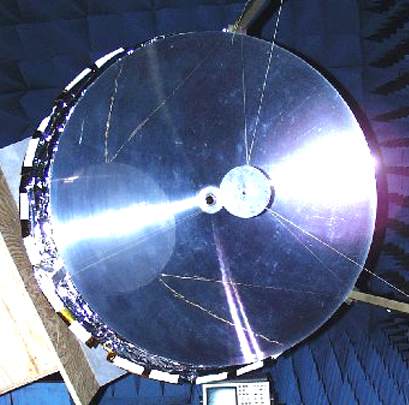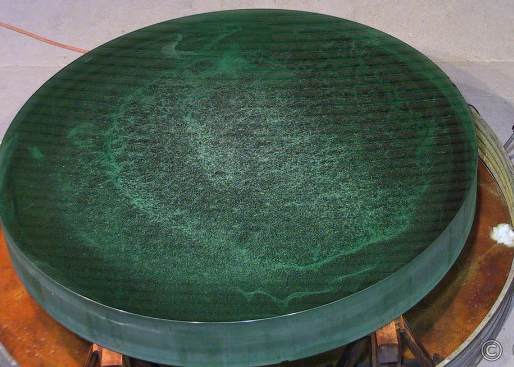Telescopes 100 years ago
I was researching the history of telescopes, and it turned out that about a hundred years ago, people finally realized how much more potential there is in reflecting telescopes as compared to telescopes-refractors. On Mount Wilson in California, astronomer George Ellery Hale and optician George Willis Ritchie (yes, everyone was called George at that time) was building large reflectors that promised the future of astronomy.

But even before they built them, Hale and Ritchie conceived more and more large telescopes. They wanted to build a 254-centimeter reflector and received a grant of $ 45,000 from an entrepreneur from Los Angeles, J.J. Hooker in 1906. And for building a reflector, the most important is a giant mirror. Like this:
')

Then $ 45,000 was hard to find, so they had to make sure they got a good blank for the mirror, which Ritchie would then polish. Therefore, they contacted the French glass company Saint-Gobain and said that they needed a 254-cm blank. The company has never made such large mirrors (and no one has done). At first they tried to make a mold and pour the glass there at one time, but nothing came of them, after which they realized that they would need too much glass (more than 4 tons) to do it in one casting. The next time they poured glass from three different sources. But due to the peculiarities of the cooling process, they received glass with a very large number of bubbles, especially at the edges where the flows occurred.
When Ritchie received glass in 1910, he refused to work with him, stating that grinding and polishing would lead to cracking in the place where there are bubbles, and the glass would not focus on the light properly anyway. Therefore, he demanded a remake of the mirror, and demanded it three times in a row. But, seeing the converted blanks, he realized that he had no other choice, and began working with blanks, saturated bubbles, being convinced that it would not work out anyway. Here is how the mirror looked at the end of the work:

By 1917, finally, the mirror was installed on a telescope that was on Mount Wilson, and was ready to receive the first light. The opening was scheduled for November 2, 1917. But the description of what happened next, you will not find on the official sites. A bunch of reporters who took a huge amount of pictures were invited. Some people were skeptical, believing that nothing would work out because of the poor quality of the glass, and that the telescope could not focus anything. The night came, the telescope was sent to the sky, looking forward to receive the first image from the new, largest and most powerful telescope in the world. But the image was not focused! Hours passed, the sky completely darkened, and journalists gradually dispersed, disappointed with the terrible failure of the telescope. What is the point that he has a collection of light three times more if he can not focus the image?
As a result, only the telescope operator remained in the building. And he saw something wonderful. The fact is that when the dome was open during the day, the glass became very hot in the sun and expanded. The mirror had to be cooled before focusing the image. And as the night progressed, the distortion decreased and decreased, and about 5 hours after everything was gone, everything was perfectly focused. Ritchie polished the mirror to an ideal state, and the bubbles had no meaning. The journalists left, but the telescope worked perfectly. Over the next ten years, Hubble and Humanson discovered the expansion of the universe with its help, as well as the fact that spiral nebulae were in fact different, distant galaxies! And everything else, as they say - is history.

But even before they built them, Hale and Ritchie conceived more and more large telescopes. They wanted to build a 254-centimeter reflector and received a grant of $ 45,000 from an entrepreneur from Los Angeles, J.J. Hooker in 1906. And for building a reflector, the most important is a giant mirror. Like this:
')

Then $ 45,000 was hard to find, so they had to make sure they got a good blank for the mirror, which Ritchie would then polish. Therefore, they contacted the French glass company Saint-Gobain and said that they needed a 254-cm blank. The company has never made such large mirrors (and no one has done). At first they tried to make a mold and pour the glass there at one time, but nothing came of them, after which they realized that they would need too much glass (more than 4 tons) to do it in one casting. The next time they poured glass from three different sources. But due to the peculiarities of the cooling process, they received glass with a very large number of bubbles, especially at the edges where the flows occurred.
When Ritchie received glass in 1910, he refused to work with him, stating that grinding and polishing would lead to cracking in the place where there are bubbles, and the glass would not focus on the light properly anyway. Therefore, he demanded a remake of the mirror, and demanded it three times in a row. But, seeing the converted blanks, he realized that he had no other choice, and began working with blanks, saturated bubbles, being convinced that it would not work out anyway. Here is how the mirror looked at the end of the work:

By 1917, finally, the mirror was installed on a telescope that was on Mount Wilson, and was ready to receive the first light. The opening was scheduled for November 2, 1917. But the description of what happened next, you will not find on the official sites. A bunch of reporters who took a huge amount of pictures were invited. Some people were skeptical, believing that nothing would work out because of the poor quality of the glass, and that the telescope could not focus anything. The night came, the telescope was sent to the sky, looking forward to receive the first image from the new, largest and most powerful telescope in the world. But the image was not focused! Hours passed, the sky completely darkened, and journalists gradually dispersed, disappointed with the terrible failure of the telescope. What is the point that he has a collection of light three times more if he can not focus the image?
As a result, only the telescope operator remained in the building. And he saw something wonderful. The fact is that when the dome was open during the day, the glass became very hot in the sun and expanded. The mirror had to be cooled before focusing the image. And as the night progressed, the distortion decreased and decreased, and about 5 hours after everything was gone, everything was perfectly focused. Ritchie polished the mirror to an ideal state, and the bubbles had no meaning. The journalists left, but the telescope worked perfectly. Over the next ten years, Hubble and Humanson discovered the expansion of the universe with its help, as well as the fact that spiral nebulae were in fact different, distant galaxies! And everything else, as they say - is history.
Source: https://habr.com/ru/post/396253/
All Articles